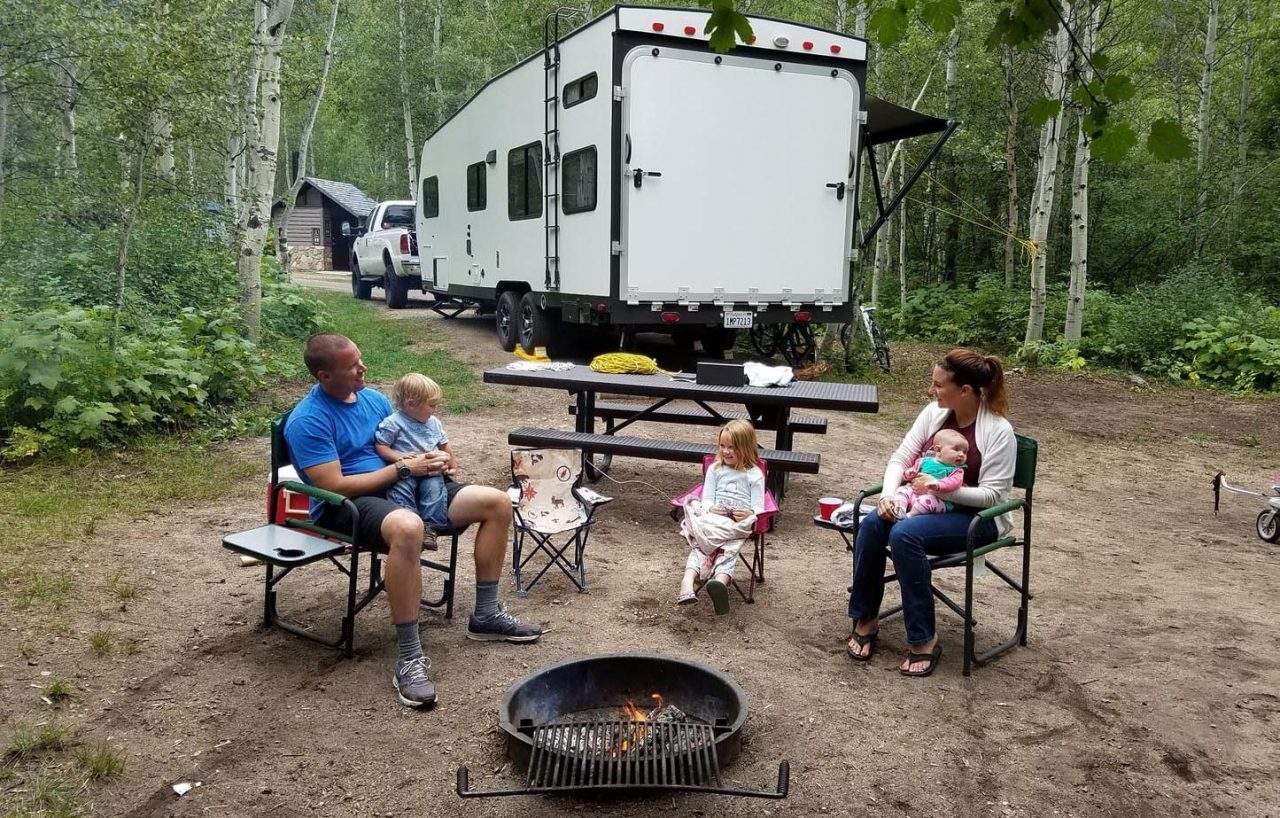Motorhome and travel trailer rentals are popular ways to enjoy a family camping vacation. But if you have a child that is required to travel in a car seat, you’ll have a little more to think about on your family road trip. Not all RVs are created equal, so you’ll want to look at the differences between RV types and know what you need to do to adhere to RV seat belt laws.
In this article, we’ll break down how you can travel with a small child in the different types of RVs, as well as provide some general safety tips.
RVs For Rent Near You
RV Seat Belt Laws
Seat belt laws aren’t exactly like the ones you have to follow in a passenger car. In some states, large RVs are exempt altogether from seatbelt requirements. Others require seat belts in the front seats only. Over half of the states in the US have certain requirements based on the age of the child. Check out this article for a state-by-state breakdown of Rv seatbelt laws.
So you can see where things would get a little confusing, especially if you are embarking on a cross-country journey.
Legality aside, experts recommend adhering to the strictest recommendations. This will ensure that you are both safe and following the law, no matter where you are.
Safety Tips for Traveling with Kids in an RV
When planning an RV trip with kids, prioritize safety. Opt for Class A or Class C motorhomes with approved anchor points for car seats. Store loose items securely to prevent injuries in sudden stops. Educate kids about RV safety, like staying seated while moving, to ensure a worry-free journey.
Choosing the Best RV for Family Travel
Not all RVs are equally suited for traveling with young children. Class C motorhomes often provide seat belt anchor points compatible with car seats, while towable RVs are typically off-limits for passengers in transit. Look for features like sturdy seating arrangements, extra storage, and family-friendly layouts when renting or purchasing an RV.
These additions provide valuable information, improving both readability and SEO by targeting keywords like “RV car seat laws” and “RV travel safety for families.”
Traveling with Children in an RV
There are four main types of RV types: Class A, B, and C motorhomes and travel trailers. Each type has its own unique seating situation.

Traveling in a Class A RV
Class A RVs are big bus-like motorhomes weighing anywhere from 17,000 pounds to over 40,000 pounds. They usually have a basement area underneath the RV and large windshields that allow great views from the front seats. Most newer Class As have been built with lap restraints in rear seats and dinettes. This would allow for attaching car and booster seats. However, no vehicles over 10,000 pounds are required to be crash-tested, and therefore, do not have to meet federal seat belt requirements.
Also be aware that even if the RV is equipped with shoulder and lap restraints, the cabinetry and seat bases in dinettes may come apart in a crash, rendering the car seats useless. Always look for setups that are mounted to the frame directly. Here’s an explainer video from Thor Motor Coach that demonstrates how to safely install a safety seat in an RV.
The Verdict
While it may be legal for children to roam about the RV in a large rig like this, it isn’t safe. Even some seats may provide a false sense of security as they aren’t actually bolted to the frame and can come apart in the event of a crash.
As for car seats, most state laws required that they are installed in accordance to manufacturer’s instructions. This means if you have your child strapped into a car seat on a side- or rear-facing bench, you are, in fact, breaking the law.
Traveling in a Class B RV

Class B RVs are essentially large vans— you may have even heard them referred to as “camper vans”. They usually have two or three front seats, but may be equipped with a back seat or bench that is bolted onto the chassis. Many of these models weigh between 6,000 and 8,000 pounds and are required to pass federal seat belt standards. This means that car seats can be safely attached to back passenger seats. Most rear sofas and dinettes in Class Bs also offer lap belts.
The Verdict
Because these RVs are subject to traditional passenger car seat belt laws, everyone must be strapped in securely. Luckily, many camper vans have seats much like you’d find in a minivan.
Be sure to double-check with the owner of the camper van before renting. Some owners choose to take out seats to make more room for camper amenities. Make sure everyone will have a place to sit and be securely strapped in. As with the Class A, never affix a car seat to a side- or rear-facing bench.

Traveling in a Class C RV
Class C RVs are also built on a truck chassis and are usually recognized by the bed over the truck cab. But unlike the Class B vans, these RVs usually weigh over 10,000 pounds. This means they are not required to pass federal seat belt standards.
Luckily, it’s not too hard to find a Class C with a crew cab, meaning it has a back seat like a large pickup truck. This would be the safest place for a child. If there are shoulder and lap belts in the cabin, inspect them. Ensure that belts are attached to the chassis frame and not just the boards in the bench seats. And again, only utilize forward-facing seats.
The Verdict
As is the case with the Class A, everyone is safer when properly secured. The backseat of the truck cab is the safest place for kids both in and out of the car seat.
Traveling While Pulling a Travel Trailer
Trailers that are pulled behind a truck, like fifth wheels, travel trailers, pop-up campers, and teardrops all require a tow vehicle to get to the campsite. This means your children will be traveling with you in a truck or large SUV that has passed crash testing and meets federal seat belt standards.
It is also safer because fewer items are around you that can become airborne during a crash. Similarly, the frame of the tow vehicle is structurally stronger than an RV. This makes a trailer the safest class of camper for children because they won’t be traveling in the recreational vehicle at all— only residing in it while it’s at rest.

Other Solutions for RV Travel with Young Children

Some RVs only offer lap belts. If you have children aged 3+ and want to give them the best protection with a shoulder strap system, there are a few alternatives. The Ride Safer Travel Vest offers a shoulder harness that hooks on the RV’s lap belt. It has a tether and neck pillow and is certified for use in U.S. automobiles. The vest system comes in three sizes, is adjustable, and can handle children who weigh between 30 pounds and 110 pounds.
Take a Separate Car
Another option is to drive a separate vehicle to the campground. Your children could ride safely in their car or booster seats as one adult drives them and the other drives the motorhome. Once at the site, your second vehicle can be used to run errands and day trips from the campground. It’s a win-win!
FAQ: RV Rules for Kids and Car Seats
Find answers to the most commonly asked questions about traveling with kids in car seats in an RV.
Are car seats allowed in all RV types?
Yes, but they must be installed in forward-facing seats with appropriate seat belts. Booster seats require lap-and-shoulder belts.
Can children ride in the back of a motorhome?
Only in forward-facing, seatbelt-equipped seats. Side-facing seats or unsecured furniture are unsafe.
Are car seat laws for RVs different by state?
Yes, laws vary. Always check regulations for the states on your route.
Can I use a rear-facing car seat in an RV?
Yes, but only in a forward-facing seat with proper anchor points.
Are lap belts safe for car seats in an RV?
No, lap belts alone are not sufficient for car seats. A lap-and-shoulder belt is required for proper installation.
Can kids sleep in beds while the RV is moving?
No. All passengers must remain seated and secured with seat belts while the RV is in motion.
What’s the safest seating location for kids in an RV?
The safest spot is a forward-facing seat with seat belts or tether anchors, near the driver’s area. Avoid side- or rear-facing seats.
Can I install a tether anchor system in my RV?
Yes, aftermarket tether anchor systems can be installed. Consult a certified technician for proper installation.
Are booster seats required for older kids in an RV?
If the child fits booster seat criteria (by height, weight, or age), they must use one with a lap-and-shoulder belt.
Do RV rental companies provide car seats?
Most don’t. Bring your own car seat to ensure it meets safety standards and fits securely.
What should I do if my RV lacks proper seat belts?
Children should not ride in an RV without seat belts. Consider choosing a different RV model or installing approved seat belts.
Hit the Road
There are many variables for safe travel with each type of motorhome or travel trailer. Just remember that most RVs are not crash-tested like automobiles. Anything weighing more than 10,000 pounds is not required to pass federal seat belt standards.
RV seat belt laws aside, the best rule of thumb is to simply make sure your kiddo has a proper seat with a seatbelt or is properly secured in a car seat. You can avoid problems with safe driving practices, slower travel speeds, and extra care in high winds.
RVing is a great way to make memories with your family. Just be sure that everyone can get to their destination safely. Decide on what works best for your family and test out an RV by renting one from Outdoorsy.









